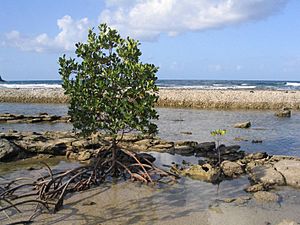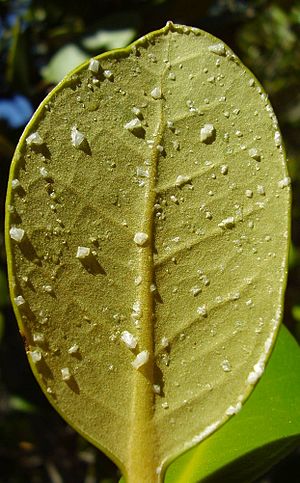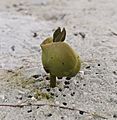Mangrove facts for kids

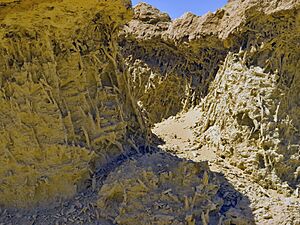
Mangroves are special trees or shrubs that grow in salty water. You can find them in warm places called the tropics. These trees create a unique saltwater habitat known as a mangrove swamp or mangrove forest. Mangroves cover about one-third of all tropical coastlines. They are also found in warmer parts of Africa, Asia, and the southwest Pacific. Their tangled roots help collect dirt and other things, which can even lead to new islands forming over time.
Contents
What are Mangroves Like?
Mangroves live right in the sea! When their seeds fall from the tree, they start growing roots as soon as they touch any soil. If the tide is low, the seeds might land in mud and begin to grow right there. But if the water is high, the seeds can float far away from their parent tree.
How Mangroves Help the Environment
Mangrove trees can often be the start of a new small island. As dirt and other things get caught in their roots, tiny pieces of land begin to form. This creates the perfect spot for other plants to grow. This is a cool example of how seeds can travel by water!
Sometimes, mangroves grow near coral reefs and help keep them healthy. Their roots have special air passages and tiny breathing holes. These help the plant get oxygen from the air, even when parts of the plant are underwater. Mangrove roots also help keep the water clear for corals. They do this by trapping dirt and filtering out pollution from land. The trees also protect the shoreline from erosion caused by strong waves. Mangrove forests are great homes for many fish, shrimp, and crabs that live near coral reefs.
Amazing Mangrove Adaptations
There are about 110 different types of mangroves. About 54 of these are "true mangroves." This means they almost only grow in mangrove habitats. These plants have found amazing ways to deal with tough conditions. They can handle changing salt levels, tides, muddy soil with little oxygen, and strong sunlight. The most different kinds of mangroves are found in New Guinea, Indonesia, and Malaysia.
How Mangroves Breathe Underwater
Red mangroves can live in areas that are often covered by water. They have special "stilt roots" that lift them above the water. These roots have tiny holes called lenticels that help them breathe. Black mangroves usually grow on higher ground. They have many "pneumatophores," which are like straw-shaped roots that stick up out of the mud to breathe. These also have lenticels.
These breathing tubes can be up to 30 centimeters tall, and some can even be over 3 meters! There are different types of these breathing roots, like stilt roots, snorkel roots, knee roots, and ribbon roots. The roots also have wide air passages inside to help move gases around the plant.
How Mangroves Deal with Salt
Red mangroves have roots that are very good at keeping salt out. They act like a super filter, blocking 90% to 97% of the salt from entering the plant. Some mangroves, like white or grey mangroves, can get rid of salt directly. They have two salt glands at the base of each leaf. You can often see white salt crystals on their leaves!
How Mangroves Save Water
It's hard to find fresh water in salty soil. So, mangroves have ways to stop losing too much water from their leaves. They can close tiny pores on their leaf surfaces called stomata. These pores usually let out water vapor. Mangroves can also turn their leaves to avoid the strong midday sun. This helps reduce how much water evaporates from the leaves.
Getting Nutrients from Muddy Soil
The soil where mangroves grow is always wet and has very little oxygen. This means it's hard for plants to get nutrients. But mangroves have their special aerial roots (pneumatophores) that help them absorb gases directly from the air. They can also get other nutrients, like iron, from the tough soil. Mangroves can even store gases inside their roots, using them even when the roots are underwater during high tide.
Mangrove Life Cycle and Offspring
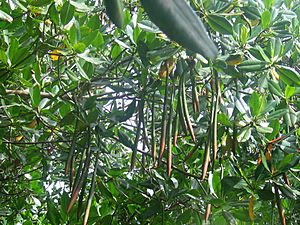
Mangroves have a special way to help their young survive in this difficult environment. Their seeds can float, which is perfect for spreading by water. Unlike most plants, whose seeds sprout in the soil, many mangroves (like the red mangrove) are "viviparous." This means their seeds start to grow while they are still attached to the parent tree!
Once the seed starts growing, it forms a "propagule." This is like a ready-to-go seedling that can make its own food through photosynthesis. The mature propagule then drops into the water and can float for long distances. These propagules are tough! They can survive drying out and stay dormant for over a year until they find a good place to grow. When a propagule is ready to root, its weight changes. It floats vertically instead of horizontally, making it more likely to stick in the mud and grow roots. If it doesn't root, it can change its weight again and float off to find a better spot.
Images for kids
-
Mangroves are hardy shrubs and trees that thrive in salt water and have specialised adaptations so they can survive the volatile energies of intertidal zones along marine coasts
-
Global distribution of native mangrove species, 2010 Not shown are introduced ranges: Rhizophora stylosa in French Polynesia, Bruguiera sexangula, Conocarpus erectus, and Rhizophora mangle in Hawaii, Sonneratia apelata in China, and Nypa fruticans in Cameroon and Nigeria. -
Nipa palms, Nypa fruticans, the only palm species fully adapted to the mangrove biome -
Circular representation of the chloroplast genome for the grey mangrove, Avicennia marina
See also
 In Spanish: Manglar para niños
In Spanish: Manglar para niños



